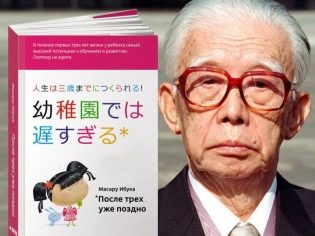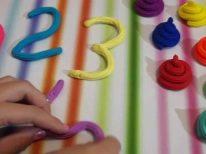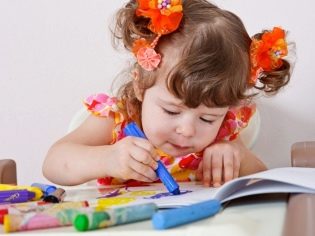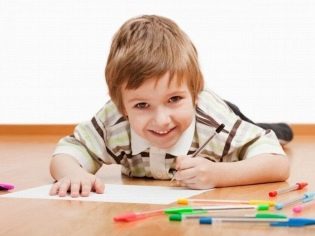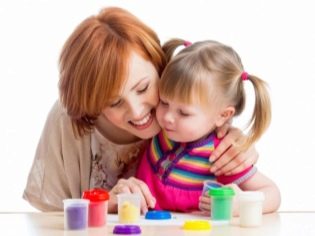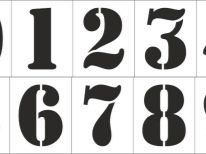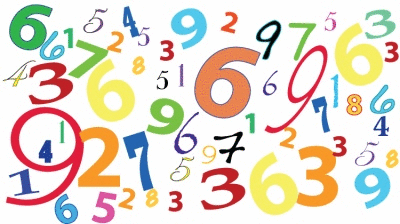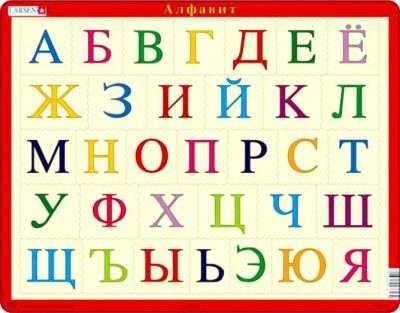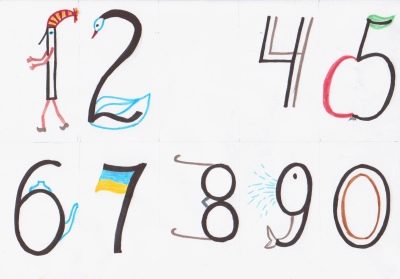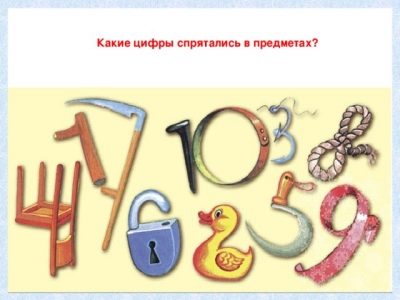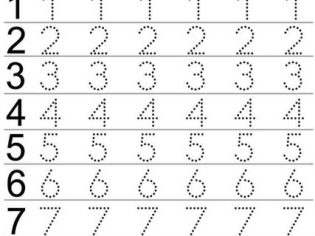How to teach a child numbers?
To teach a child numbers, you must not protect him from them and let him be interested because of his age, always answering his questions.
Basics: how to teach a child numbers?
Each child is an individuality, therefore it is impossible to measure all children with one measure. It is always more correct to evaluate the actions and actions of any person. You can't compare children to each other, you need to compare the child with him: how he was yesterday and how he became today.
How old should a child know the numbers?
The answer to this question is the personal experience and the unique author's program for the development of the child, Masaru Ibuka, a famous Japanese businessman, founder and chief engineer of Sony Corporation. The title of his publication speaks very categorically for itself: “After three years it’s too late”.
All psychologists and educators agree with him: for up to three years, the child’s brain is so plastic, free, pliable, inquisitive and efficient, that not using its capabilities during this period is simply a crime.
An interesting fact: up to seven years, the baby has time to master such a volume of information, which is comparable only to the dimensions of the knowledge gained by a person for the rest of his life.
If the crumbs do not have problems with the sign system, and it is interesting for parents to know how and how their child lives, then even numbers and even children can learn in three and even two years without problems.
We learn the smallest
Everything is simple with kids: bright, funny, mobile always attracts them:
- Therefore, we use soft toys, figures, poems about them and the account, and the child will unwittingly become interested in the characters that are unfamiliar to him.
- The wallpaper in the nursery with numbers (a train with numbered cars, houses of animals on a forest street) work well in this regard.
- Children love to sculpt, which means we play with clay and dough and make digital signs. From the dough, you can even bake cookies.
The study of numbers for a small "Einstein" - a very interesting activity. Children can easily be promoted to developmental lessons at any age, if this process does not violate the psyche of the child. It is kids who are most interested in symbols, and if adults are limited to indifference at best, then an excruciating for a child acquaintance with numbers will be delayed until he is five or six years old. Adults should remember that to teach the child anything you need on time: road spoon for dinner.
Education at 4 years
A child at the age of 4 is already the youngest preschooler, so there are far more requirements for his mental development than before.
The time has come for active work on fine motor skills of the hand. The easiest way to do this in the process of all children’s favorite activity is drawing.
The child will learn to distinguish the numbers and correlate them with a specific (specific) number, as well as to draw them independently.
Drawing will allow you to optimally prepare the kid for the letter thanks to:
- development of small muscles of the hand;
- active formation of visual and motor images of each of the figures.
Stages of drawing:
- several times the crumb draws a large figure;
- draws smaller images.
Children need to be able to draw materials of different colors - then the exercises will bring joy.
The development of visual-motor coordination is facilitated by such tasks as "tracks":
- With colored pencils, a child passes a race track drawn on paper, tangled and winding. We must not fly out of the road at the turn.
- Cut out complex-shaped roads from cardboard or thick paper and arrange Formula 1 competitions, running small toy cars on the track.
This game will also make it easier for the kid to learn the letter.
It is advisable to select tasks that are constructed in such a way as to ensure the development of attention and the beginning of logical thinking, and also to provoke him to non-standard solutions:
- We look at the number with a crumb and try to find around objects, at least somehow associated with the figure in appearance (form).
- We sculpt a figure from salt dough, from plasticine, lay it out using macaroons, matches, we write on asphalt, on sand, on snow.
- We read S. Ya. Marshak “Let's get acquainted”, trying to learn the one we liked.
Adults should pay attention to the following in this children's activity:
- whether the child is sitting correctly (taking care of his posture and keeping his eyes);
- holding a brush, pencil, wax crayon, felt-tip pen;
- a kid should always have enough materials for his favorite work: albums, pencils, crayons, coloring books, stencils;
- All classes should be conducted only in the form of a game and only if the child wishes.
Classes at the age of 5-6 years
After the stage of familiarization of the child with the process of education of any number, you can begin to closely communicate with the child with the numbers.
He will also know the printed version that he sees in a newspaper, magazine, book, and handwritten in the notebook of the older children in the family.
It is possible to educate a child at the age of 5-6 years more thoroughly and more purposefully, because this is the average preschool age. and requires a more careful attitude of adults to the knowledge and skills of the crumbs:
- If the baby has no problems with the sign system, he calmly remembers and quickly learns to recognize and recognize the graphic image of all ten digits, and if there is, it is difficult to memorize some numbers and get confused.
- In children with speech therapy there is a mirror perception of numbers, and this happens more often with numbers: 1, 3, 4, 5, 6, 7.
Some numeric characters require special attention:
- 3 - is similar to the letter "Z" for preschoolers who have already comprehended the Russian alphabet.
- 4 - the printed image is perceived in two ways because of the variability in print, and the written one is similar to the letter “H”.
- 6 and 9 - it's hard for guys not to confuse them, because the graphic images of these figures differ only in the rotation around their own axis by 180 °.
Learning numbers and numbers correctly
Before explaining anything about numbers and numbers to a child, adults should clearly understand the difference between these two concepts:
- It is important not to confuse: a digit is a sign used to designate a number, a number is the value at which an account is made.
- You can draw a parallel with the sounds and letters: the sounds are what we hear and pronounce, and the letters are symbols (icons) to indicate sounds on the letter.
- Thus, the letters make up the alphabet, and therefore the numbers - this is also a kind of "alphabet", with the help of the symbols of which you can write any number.
Numbers (their record) consist of numbers in the same way as words in a record consist of letters.
The Russian alphabet has only 33 letters, and you can make an infinite number of words out of them.
We have only ten figures: 0,1,2,3,4,5,6,7,8,9, but it is possible to make from them infinitely many numbers. Each time adding to the number 1, we get the following number.
Each figure in the solo version (alone) indicates a single-digit number in the record. In the record of two-digit numbers - two icons (numbers), and in the record of three-digit numbers - three characters (numbers) and so on.
Numbers in which we use more than one digit are called multi-valued.
To avoid confusion, children need to explain:
- Among the numbers from 1 to 20 there are two groups: one-digit and two-digit.
- Numbers after 10 are formed like this: we put one on “twenty” (ten) and get 11, put two on “twenty” and get 12, and so on.
- We study 2,3,7,6,10 as a demonstration of the difference between single-digit and two-digit numbers, emphasizing that 10 is the smallest two-digit number, and 9 is the largest single-digit number.
- Numbers from 1 to 100 make up the first "hundred", but 100 is the smallest three-digit number.
Colors to help
The use of bright colors and shades has a beneficial effect on the psyche of the child and serves as a kind of color therapy:
- bright colors always raise your mood and vitality;
- a box of 18 or 24 colored pencils will allow the child to feel more confident - he will have many colored helpers;
- bright colors have a positive effect on the unformed child's psyche, the child’s fear of the new and the unknown disappears.
How does the color diversity, can be seen in the examples:
- The child will be happy to color both the big number and the drawing for it. For example, to the "seven" - drawn rainbow, to the "three" - a fabulous family of bears.
- Having studied the new figure, we will try using colored pencils to color the clothes of the characters in the children's coloring, putting a “digital print” on it.
Counting materials
Depending on which analyzer (visual or auditory) the person has, the leader is better developed, the form and method of the presented information will depend.
It is a well-known fact: for most people (and for small ones, even more so) the visual analyzer is naturally better developed. No wonder they say that it is better to see 1 time than to hear 100 times.
Children are a special audience, requiring vivid impressions, unusual tricks, memorable objects. All their mental processes are often involuntary. It requires adults thorough preparation for classes with the child.
How to help your child?
Calmly explaining to a baby is not an easy task. In this process, it is important not to go down to the level of the child, but try to raise the baby one step higher than its previous position, bringing it closer to you.
Method of familiarization
After acquaintance with the new number, and exercise, you should try to consolidate the knowledge gained: with the child to find familiar numbers on the surrounding objects - on the pages of favorite books, on house numbers, on the doors of apartments, but mailboxes, on numbers cars and so on.
If the child does not fully understand the material being studied, it is necessary to additionally perform similar tasks with him, and after a while it is necessary to return to the easy topic and repeat it. The material is studied from simple to complex. You can not move forward without assimilating the previous material, because it is the basis, the foundation for the study of subsequent topics.
Game Forms
Teaching preschool children requires constant play:
- "Find the right pictures." The student is asked to connect with a pencil all the pictures with the corresponding number of subjects.
- "Every picture figure." For each picture to choose a number that corresponds to the number of objects on it.
- "Pick up the card." To the covers of popular books to pick up a card with a number. For example: "Three bears", "Flower-seven flower".
- "Figures of the artist" - we draw a continuous chain of "eights" - it turns out a round dance of dolls, randomly scattered "triples" - fluttering birds, a line of "units" - a fence.
- "Draw a portrait of numbers." Adults read the description of the number in verse, and the child must draw it.
- "Figure with a secret." Connecting the dots with one code number next (for example, the "six"), the child will receive a drawing (for example, a baby elephant).
- "Funny numbers." The kid guesses numbers in unusual drawings, where they are hidden in a funny plot.
- "Talking numbers". According to the story figures about yourself crumb must guess who it is. For example, what number I will tell the traffic light. Or I - the favorite assessment of all students. Or all loafers are afraid of me.
Learning to count quickly
Having learned to count quickly from 1 to 9, the child will be able to visually remember the order of numbers in the number series, which will help him to control himself, remembering how the graphic image of a digit looks.
Consolidation of the material studied
To make sure that the child has learned the numbers and their images, you can write with him a “mathematical dictation”:
- number the largest single digit;
- what number denotes "empty" and "nothing";
- write down the number that “lives” between 4 and 6 in the series of numbers;
- Answer number: three times 2.
The letter of numbers is best fixed in a notebook in a large cell or in a special “Recipe”.
At the stage of consolidation, you can use geometric shapes: three triangles, three squares and three ovals, each of which is repeated in three colors: yellow, red and blue.
On triangles we write 1, on squares-2, on ovals-3. We ask the child to group the shapes by any method known to him. Variants of choice are determined by him: by color, by form, by written number.
To learn how to teach a child figures, see the following video.



